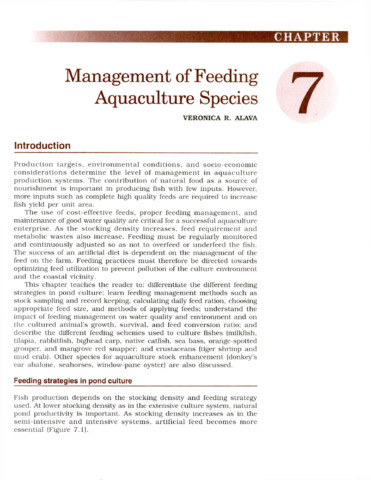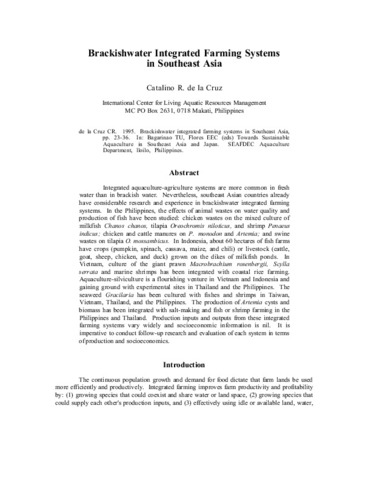Philippine National Standard: Organic aquaculture
- Global styles
- MLA
- Vancouver
- Elsevier - Harvard
- APA
- Help

Download URL
bafs.da.gov.phDate
2016Page views
8,761ASFA keyword
AGROVOC keyword
Taxonomic term
Metadata
Show full item record
Share
Abstract
The Philippine National Standard (PNS) for Organic Aquaculture (PNS/BAFS 112:2016) was originally prepared and adopted in 2012. Organic aquaculture encourages polyculture production system, promotes the use of indigenous/endemic species under the extensive and semi-intensive culture systems, reduces/minimizes inputs of artificial ingredients, prohibits the use of genetically modified organisms (GMOs), and considers ecological conditions necessary for sustainable aquaculture production.
The PNS for Organic Aquaculture was revised by the Technical Working Group (TWG) organized by the Bureau of Agriculture and Fisheries Standards (BAFS) through a Department of Agriculture (DA) Special Order No.476, Series of 2015. The TWG is composed of members representing the Bureau of Fisheries and Aquatic Resources (BFAR), Organic Certification Center of the Philippines (OCCP), Southeast Asian Fisheries Development Center Aquaculture Department (SEAFDEC-AQD), Philippine Council for Agriculture, Aquatic and Natural Resources Research and Development (PCAARRD) and Central Luzon State University (CLSU). This PNS was presented and reviewed during the consultative meetings with the concerned stakeholders in Region I (Pangasinan) and Region XI (Davao City). Comments gathered during the consultations were carefully evaluated by the TWG and included accordingly in the final version of this standard. Drawn from the general principles of the Philippine National Standard on Organic Agriculture, this PNS on Organic Aquaculture attempts to cover the aquaculture production and postharvest operations in order to ensure the integrity of organic products. The requirements for the inclusion of Substances and Criteria for the development of the list of substances shall follow the Philippine National Standards for Organic Aquaculture and the Guidelines for the Production, Processing, Labelling and Marketing of Organically Produced Foods (GL 32-1999).
The revision of this PNS was undertaken in order to achieve equivalence with the existing international standards and its future amendment, and takes into consideration the new developments and inclusion of the identified potential species for organic aquaculture. Thus, this PNS identifies minimum requirements on documentation, conversion to organic aquaculture, parallel production, selection of site, interaction with surrounding ecosystem, organic fertilization, aquatic plants, aquatic animal sources/origin, breeding and hatchery management, aquatic animal nutrition and feeding, aquatic animal health and welfare, harvesting, post-harvest handling, transport and processing, storage, and social aspects.
Suggested Citation
Bureau of Agriculture and Fisheries Standards. (2016). Philippine National Standard: Organic aquaculture (PNS/BAFS 112:2016). Quezon City, Philippines: Bureau of Agriculture and Fisheries Standards.
Type
BookCollections
Related items
Showing items related by title, author, creator and subject.
-
Management of feeding aquaculture species
Alava, Veronica R. (Aquaculture Department, Southeast Asian Fisheries Development Center, 2002)This chapter teaches the reader to: differentiate the different feeding strategies in pond culture; learn feeding management methods such as stock sampling and record keeping, calculating daily feed ration, choosing ... -
Competitive and comparative advantages of brackishwater aquaculture of tiger shrimp, mud crab, and milkfish in the Philippines in 1985-1995
Gonzales, Leonardo A.; Elca, C. D.; Gonzales, V. A.; Alviola IV, Pedro A.; Paraguas, F. J.; Olalo, C. (Bureau of Agricultural Research, Department of Agriculture, 2007)The brackishwater aquaculture sector contributes considerably to the growth of the fisheries sector. Tiger shrimp Penaeus monodon, mud crab Scylla serrata, and milkfish Chanos chanos, in particular are efficient users of ... -
Brackishwater integrated farming systems in Southeast Asia
De la Cruz, Catalino R. (Aquaculture Department, Southeast Asian Fisheries Development Center, 1995)Integrated aquaculture-agriculture systems are more common in fresh water than in brackish water. Nevertheless, southeast Asian countries already have considerable research and experience in brackishwater integrated farming ...





